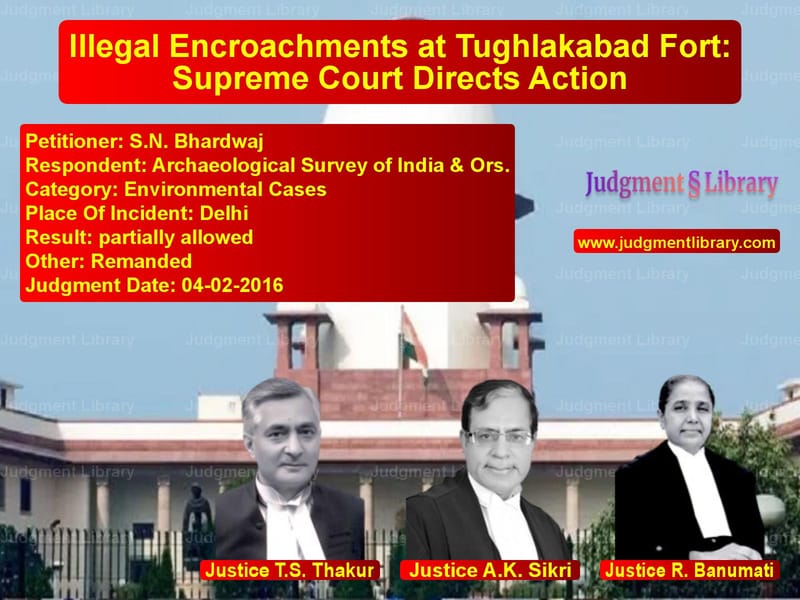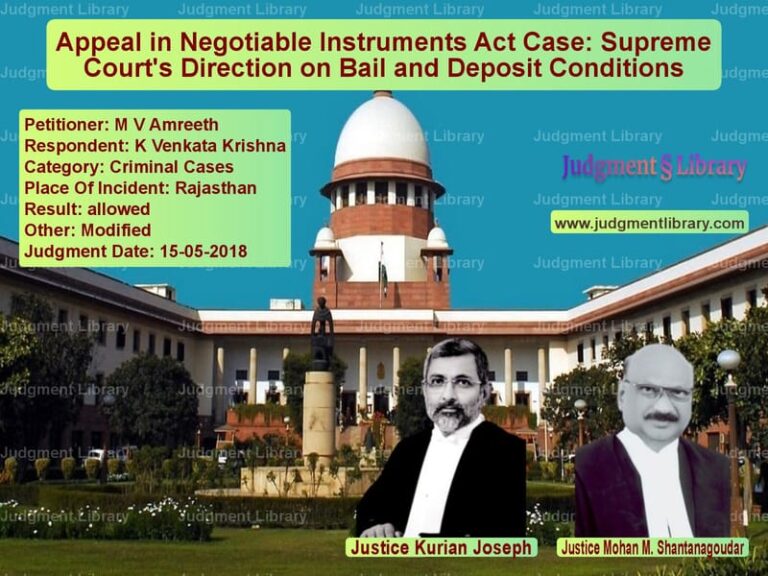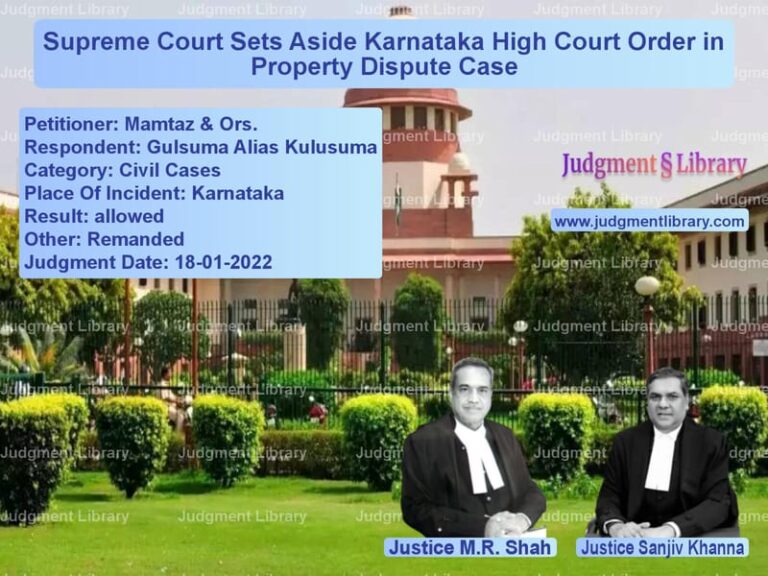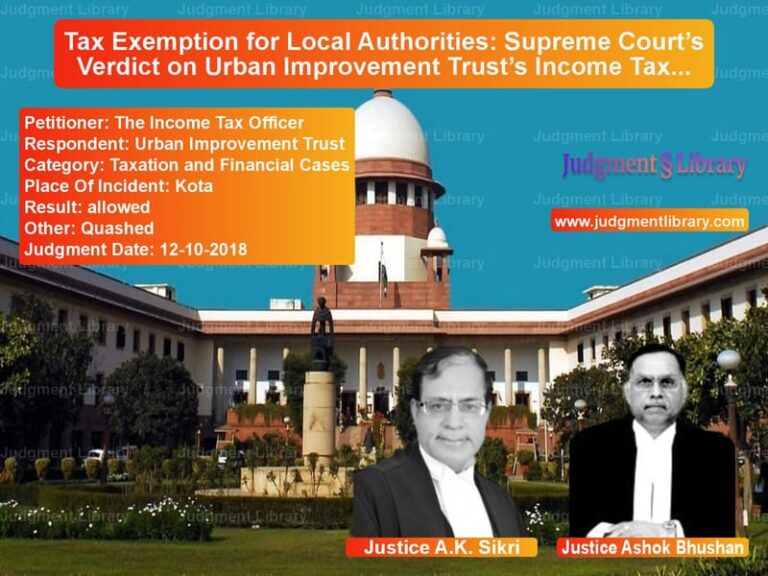Illegal Encroachments at Tughlakabad Fort: Supreme Court Directs Action
The case of S.N. Bhardwaj vs. Archaeological Survey of India & Ors. highlights a significant issue of illegal encroachments on the historic Tughlakabad Fort, a protected monument in Delhi. The Supreme Court addressed the failure of authorities in preventing unauthorized construction and directed action to protect and preserve the heritage site.
Background of the Case
The Tughlakabad Fort, built by Sultan Giyasuddin Tughlaq (1321-1325 A.D.), is one of the largest forts in Delhi, covering around 3000 bighas. It has been declared a protected monument under the Ancient Monuments and Archaeological Sites and Remains Act, making it the responsibility of the Archaeological Survey of India (ASI) to ensure its preservation.
However, over the years, the fort has suffered from severe encroachment and illegal construction by unauthorized occupants. The appellant, S.N. Bhardwaj, filed a Public Interest Litigation (PIL) in the Delhi High Court in March 2001, alleging that:
- The ASI failed to prevent illegal occupation and protect the monument.
- Government officials, including the Delhi Development Authority (DDA) and local municipal authorities, allowed encroachments to continue.
- Despite media reports highlighting the encroachment issue, no concrete action was taken.
Bhardwaj urged the court to direct ASI to remove the encroachments and sought a Central Bureau of Investigation (CBI) inquiry into how illegal constructions were allowed.
Proceedings in the Delhi High Court
The Delhi High Court heard the case on March 7, 2001, and disposed of it on the same day with a brief order:
“The concerned authorities need to look into the grievances in the proper perspective and take necessary action as warranted in law.”
Unhappy with this non-specific directive, Bhardwaj approached the Supreme Court, arguing that the High Court should have taken a stronger stance rather than leaving the matter to ASI’s discretion.
Supreme Court Intervention
The Supreme Court took note of the matter and issued notices to the respondents, including ASI and DDA. Upon reviewing the case, the Court found that attempts to remove encroachments had been hindered by interim orders from the Delhi High Court in Writ Petition (Civil) No. 2193 of 2001. The Supreme Court transferred this case and began hearing both matters together.
On March 3, 2003, the Supreme Court issued an interim order:
- No further construction should take place within the Tughlakabad Fort area.
- All agencies, including the Delhi government, DDA, and the police, must assist ASI in preventing illegal construction.
Despite this, encroachments continued, prompting further hearings.
ASI’s Failure to Act
The Supreme Court repeatedly directed ASI to file reports on the extent of encroachments. However, ASI failed to comply, citing various difficulties such as lack of police protection.
On October 14, 2011, the Supreme Court ordered ASI to conduct a survey based on aerial images from 1993 to determine how many people were living inside the protected fort. ASI did not complete this task, prompting further judicial action.
In response, the Supreme Court:
- Imposed a fine of Rs. 10,000 on ASI for non-compliance.
- Directed the Chief Secretary of Delhi and the Police Commissioner to assist ASI in its efforts.
- Mandated regular status reports on the removal of encroachments.
Final Judgment by the Supreme Court
On February 4, 2016, the Supreme Court, comprising Chief Justice T.S. Thakur, Justice A.K. Sikri, and Justice R. Banumati, delivered its final order:
- The Delhi High Court must now monitor the removal of encroachments and ensure compliance with Supreme Court directives.
- All authorities, including ASI, DDA, and local administration, must coordinate efforts to clear the fort.
- The Registry of the Supreme Court must transfer all records to the Delhi High Court.
The Court observed:
“Protection and preservation of Tughlakabad Fort is imperative. The failure of authorities to prevent illegal occupation is a serious lapse, and it is necessary to ensure compliance with the law.”
The matter is now under the supervision of the Delhi High Court, which is responsible for overseeing compliance with Supreme Court orders.
Key Legal Takeaways
- Responsibility of ASI: The ASI is legally bound to protect and maintain protected monuments, ensuring they are not encroached upon.
- Government Accountability: Failure of government agencies to prevent illegal constructions may attract judicial intervention and penalties.
- Judicial Monitoring: Courts may take an active role in supervising the implementation of orders to ensure compliance.
- Public Interest Litigation (PIL): Citizens can approach courts to protect historical sites from illegal occupation.
Conclusion
The Supreme Court’s decision underscores the importance of preserving historical heritage sites and holding authorities accountable for their protection. The transfer of the case to the Delhi High Court ensures continued oversight, preventing further illegal occupation of Tughlakabad Fort.
Don’t miss out on the full details! Download the complete judgment in PDF format below and gain valuable insights instantly!
Download Judgment: S.N. Bhardwaj vs Archaeological Surve Supreme Court of India Judgment Dated 04-02-2016-1741852457599.pdf
Direct Downlaod Judgment: Direct downlaod this Judgment
See all petitions in Public Interest Litigation
See all petitions in Fundamental Rights
See all petitions in Legislative Powers
See all petitions in Judgment by T.S. Thakur
See all petitions in Judgment by A.K. Sikri
See all petitions in Judgment by R. Banumathi
See all petitions in partially allowed
See all petitions in Remanded
See all petitions in supreme court of India judgments February 2016
See all petitions in 2016 judgments
See all posts in Environmental Cases Category
See all allowed petitions in Environmental Cases Category
See all Dismissed petitions in Environmental Cases Category
See all partially allowed petitions in Environmental Cases Category







